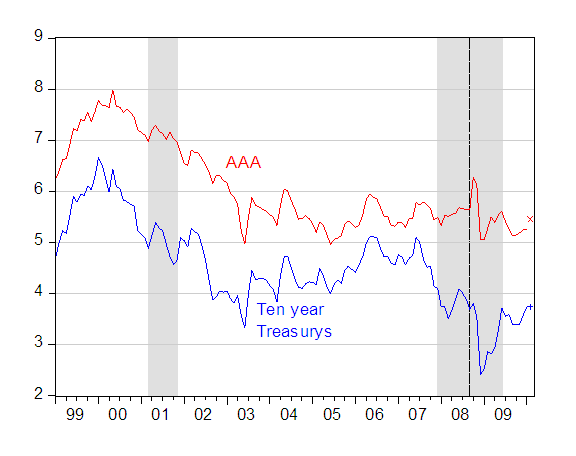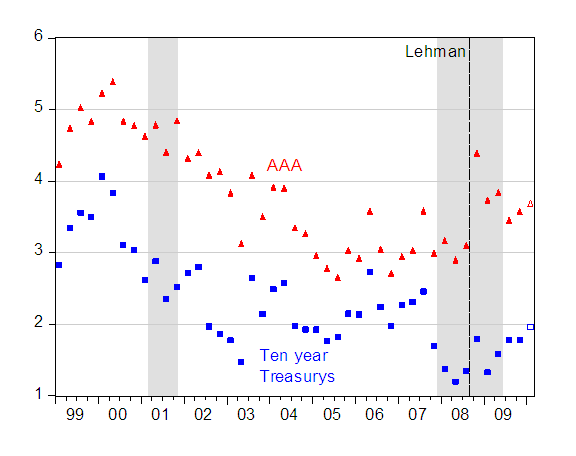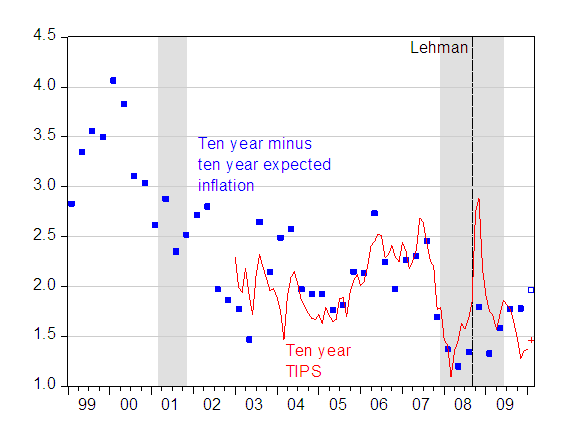There are various definitions of crowding out. There’s crowding out in the financial markets, and crowding out of actual economic activity. In order for crowding out in the financial markets to translate into a reduction of the interest sensitive components of aggregate demand, one needs to see an impact on interest rates. So, what is happening to real (inflation adjusted) interest rates?
First, let’s take a look at the nominal interest rates, both the risk free and risky.

Figure 1: Ten year constant maturity yields (blue) and AAA corporate debt yields (red). Observation for February is 2/17. NBER defined recession dates shaded gray; assumes last recession ends 09M06. Source: FRED II, and NBER.
Second, we can adjust these nominal interest rates by expected inflation rates over a ten year horizon. Here we use the Survey of Professional Forecasters predictions, which apply to February.

Figure 2: Ten year constant maturity yields (blue) and AAA corporate debt yields (red), adjusted by ten year expected inflation. Observation for February is 2/17. NBER defined recession dates shaded gray; assumes last recession ends 09M06. Source: FRED II, Survey of Professional Forecasters via Philadelphia Fed, and NBER.
Real interest rates appear to be relatively low, lower than in the previous recession. Since these estimates of the ex ante real interest rate rely upon survey based measures of inflationary expectations, one could criticize them as being mismeasured.

Figure 3: Ten year constant maturity yields adjusted by ten year ahead expected inflation (blue squares) and ten year constant maturity TIPS (red). Observation for February is 2/17. NBER defined recession dates shaded gray; assumes last recession ends 09M06. Source: FRED II, Survey of Professional Forecasters via Philadelphia Fed, and NBER.
However, the Treasury inflation protected securities (TIPS) yields suggest a similar pattern for real rates, excepting the period right after the Lehman bankruptcy, during which time TIPS and other yields behaved erratically).
So, what is one to make of these data? In a standard model of portfolio crowding out (see derivation here), budget deficits should induce higher interest rates, and hence lower investment. Of course, not all else is held constant. In particular, the Fed has aggresively purchased Treasurys and other longer term assets, including mortgage backed securities. This manifests itself in continuous shifts rightward in the LM curve.
Chapter 5 of the Economic Report of the President, 2010, notes:
…In the current situation, as discussed in Chapter 2, monetary policymakers are constrained because nominal interest rates cannot be lowered below zero, and so they are unlikely to raise interest rates quickly in response to fiscal expansion. As a result, the fiscal expansion attributable to the Recovery Act is likely to increase private investment as well as private consumption and government purchases. …
A relevant question, is what happens when the Fed exits from quantitative easing (and relatedly, as slack in the economy declines). That being said, extreme upward pressure on interest rates, and reduction in investment expenditures, is not a foregone conclusion.
Crowding out has a strong hold on many people’s imagination. Some equate crowding out in the financial market with crowding out in the real side of the economy. Let me make a couple observations on why this simplistic equation need not hold.
First, the empirical magnitude of investment crowding out depends critically on the interest sensitivity of investment expenditures.
Second, if investment depends upon the change in GDP, as in a simple accelerator model (see a discussion of competing investment models here), then government spending that induces an increase in GDP can result in higher investment, despite an increase in interest rates.
Third, when one assumes three (or more) outside assets instead of two, then money and bonds are not necessarily substitutes. Benjamin Friedman laid out a model with money, bonds and equities/capital. Depending upon whether bonds are closer substitutes with capital or money, one can obtain crowding out or crowding in (see this powerpoint presentation).
I teach crowding out in the context of the IS-LM model. For those who want to work in the loanable funds framework, see DeLong, and Krugman.
- Bulenox: Get 45% to 91% OFF ... Use Discount Code: UNO
- Risk Our Money Not Yours | Get 50% to 90% OFF ... Use Discount Code: MMBVBKSM
Disclaimer: This page contains affiliate links. If you choose to make a purchase after clicking a link, we may receive a commission at no additional cost to you. Thank you for your support!



Leave a Reply